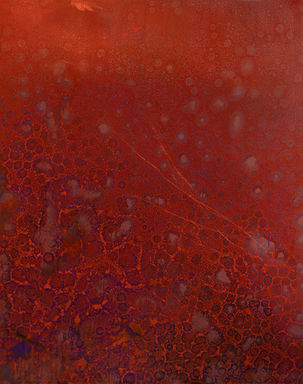
Realms Of Gold: Hisako Kobayashi
Georges Bergés Gallery, New York
Hisako Kobayashi grew up in Tokyo before moving to New York to start her MFA at Pratt Institute. She currently lives downtown on the edge of the East Village and is given to making quietly luminous paintings, often dominated by a single misted color and sometimes displaying embellishments that complicate the smooth expanse of her surface.
These paintings, highly lyrical and evocative, easily align with the American color field movement, but there is also something Japanese in the subtlety of their feeling. Kobayashi, who cannot but help to be poised between the circumstances of her Japanese background and the ongoing innovations of New York, has originated a style that pays homage to both her past and present: its combination of a tacitly Asian presence and a tie to Western painterly abstraction results in a body of work notable for its evocation of a muted, elegant sensibility.
In the main space of the gallery, Kobayashi’s paintings generate a quiet atmosphere. They are windows to a world of contemplation, in which silence and stillness hold sway. Perhaps it is the meditational element that ties Kobayashi to her Japanese past; the paintings evoke pools of memory, in which a viewer may find the depth of solace. In “Nehan” (2022), the overall color is a dark jade, whose uniformity of hue is made more complex by spheres and mottled surfaces spread across the composition. Kobayashi, always interested in a deliberate beauty, expresses exactly that in this work of art. In “Gratitude” (2022), a similar presentation occurs. The color of the painting, a deep, dark brick red, becomes the theme of the work. But the surface is more complicated than that of a single, extended hue. It is subtly decorated by effects that come close to merging with the background, but which, at the same time, serve to distinguish the painting from any experience of it as a purely flat plane. Gray spheres and blotches a darker red than the red background crowd each other in the lower part of the painting. They complicate the simple declaration of the background—a strategy that occurs regularly in Kobayashi’s art. These are works to be studied intuitively, over time, rather than analyzed and taken apart.
The dominant color in “The Messenger” (2022) is a deep blue, much like the sight of the sea. The blue is made slightly luminous by the suggestion of a white underpinning, and throughout the painting streaks of white occur, making the composition almost impossibly lyrical. Kobayashi tends to like titles with mystical implications, and the name of the painting asks that we see it as a vehicle of mystical transport. We must remember that this is the stuff of poetry, painted in a neighborhood that has become its opposite, being overcrowded and thick with the haze of gasoline! But Kobayashi is right in finding the poetic in an urban scene. She relegates her sensibility to the perception of subtle nuances, no matter the location. “Connect to the Sky” (2022), another painting with a predominantly dark red background, is made intricate by black blotches, small spheres, and rough hazes that sit on top of the overall expanse of red. The painting’s various additions are intuitive, being flourishes that occur in a random manner. In this work, as in the others, we see a contrast, almost a conflict, in which random embellishment plays off a dominant color. The result—areas of activity set upon a smooth plane—make it clear Kobayashi understands the nearly ritual elements of abstract painting.
“Tao No. 1” (2018), an oil on paper, is more evidently complex in its abstract imagery. The painting’s major color is brown, with a hint of brownish green. Lighter colored skein-like forms, nearly like lightning strikes, fill the upper half and lower left of the painting, while on the lower right, red lozenge shapes form a group. Once again, the title refers to esoteric knowledge, and the painting serves as a vehicle for precepts not easily surmised. Kobayashi is adept at creating abstractions whose force results from her connectedness to contemplative thought. Her vision may be mystical, but it is specific in its implications, namely, its appreciation of the groundedness of all things. The way she chooses to express the quality of a centered outlook is through lyric abstraction, guided by the direction the title establishes. Her art thus bridges the immediacy of paint and the larger, more complicated vision of a world beyond us. Thus, Kobayashi reminds us that art is always a bridge to somewhere else, a place existing within, and just outside, our vision.
Jonathan Goodman, June 8, 2022







